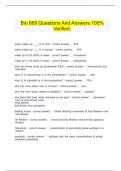Starling forces - Study guides, Class notes & Summaries
Looking for the best study guides, study notes and summaries about Starling forces? On this page you'll find 237 study documents about Starling forces.
Page 4 out of 237 results
Sort by
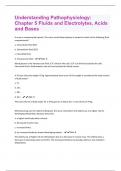
-
Understanding Pathophysiology: Chapter 5 Fluids and Electrolytes, Acids and Bases Questions and Answers(A+ Solution guide)
- Exam (elaborations) • 10 pages • 2023
- Available in package deal
-
- $7.99
- + learn more
A nurse is reviewing lab reports. The nurse recalls blood plasma is located in which of the following fluid compartments? a. Intracellular fluid (ICF) b. Extracellular fluid (ECF) c. Interstitial fluid d. Intravascular fluid - ANS: D Blood plasma is the intravascular fluid. ICF is fluid in the cells. ECF is all the fluid outside the cells. Interstitial fluid is fluid between the cells and outside the blood vessels. A 35-year-old male weighs 70 kg. Approximately how much of this weight is...
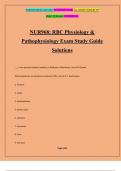
-
NUR968: RBC Physiology & Pathophysiology Exam Study Guide Solutions
- Exam (elaborations) • 62 pages • 2024
-
- $12.49
- + learn more
NUR968: RBC Physiology & Pathophysiology Exam Study Guide Solutions __: is the aqueous (water) medium or fluid part of the blood - Ans:-Plasma What substances are dissolved in plasma? (10) - Ans:-1. Electrolytes 2. Proteins 3. Lipids 4. Carbohydrates 5. Amino acids 6. Vitamins 7. Hormones 8. Urea 9. Uric acid ©GRACEAMELIA 2024/2025 ACADEMIC YEAR. ALL RIGHTS RESERVED FIRST PUBLISH OCTOBER 2024 Page 2/62 10. Oxygen, carbon dioxide & nitrogen True or false: Red blood cells, white ...
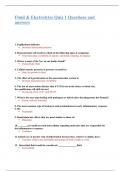
-
Fluid & Electrolytes Quiz 1 Questions and answers
- Exam (elaborations) • 8 pages • 2023
- Available in package deal
-
- $22.99
- + learn more
Fluid & Electrolytes Quiz 1 Questions and answers 1. Papilledema indicates • Increased intracranial pressure 2. Hypocalcemia will result in which of the following signs & symptoms: • Neuromuscular excitability & spasms, intestinal cramping, & tingling 3. Where is most of the Na+ in our bodies found? • Extracellular fluid 4. Colloid osmotic pressure is pressure created by: • Only the protein in fluid 5. The effect of hypocalcemia on the neuromuscular system is: • I...
Bio 669 Questions And Answers 100% Verified.
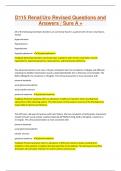
-
D115 Renal/Uro Revised Questions and Answers / Sure A +
- Exam (elaborations) • 14 pages • 2024
-
- $7.99
- + learn more
All of the following electrolyte disorders are commonly found in a patient with chronic renal failure, except: Hypernatremia Hypocalcemia Hyperkalemia Hypophosphatemia - Hypophosphatemia Feedback:Electrolyte disorders commonly seen in patients with chronic renal failure include hyperkalemia, hyperphosphatemia, hypocalcemia, and bicarbonate deficiency. The advanced practice nurse sees a 78-year-old patient who has complaints of fatigue and difficulty emptying his bladder. Examination rev...
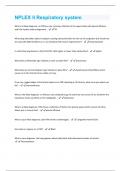
-
NPLEX II Respiratory system Updated 2024/2025 Verified 100%
- Exam (elaborations) • 6 pages • 2024
- Available in package deal
-
- $7.99
- + learn more
What is a likely diagnosis: on CXR you see a primary infection of the upper lobes with pleural effusion and hilar lymph node enlargement. - TB What drug stimulates alpha1 receptors causing vasoconstriction for the use of congestion but should not be used with MAO inhibitors or in an individual with severe hypertension? - Oxymetazoline In restrictive lung disease is the FEV1/FVC ratio higher or lower than obstructive? - Higher What does a Sillhouette sign indicate as seen on plain film? - pn...

-
Understanding Patho: Quiz 1 - Electrolytes & Immunity - Exam 1 Questions With Verified Answers
- Exam (elaborations) • 44 pages • 2024
-
- $13.49
- + learn more
Understanding Patho: Quiz 1 - Electrolytes & Immunity - Exam 1 Questions With Verified Answers What makes up approximately _______ percent of lean body weight in men? women? - answermen = 60%. women = 50%. what fraction of water is in the intracellular space? extracellular space? - answerintracellular = two-thirds. extracellular = one-third. Is the ICF or ECF subdivided into more categories? what are these? - answerECF. Into intravascular and interstitial. What percentage of the ECF ...
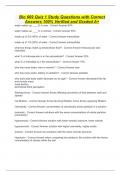
-
Bio 669 Quiz 1 Study Questions with Correct Answers 100% Verified and Graded A+
- Exam (elaborations) • 13 pages • 2024
- Available in package deal
-
- $9.99
- + learn more
Bio 669 Quiz 1 Study Questions with Correct Answers 100% Verified and Graded A+ water makes up ____% in men - Correct Answer 60% water makes up ____% in women - Correct Answer 50% made up of 2/3 (40%) of water - Correct Answer intracellular made up of 1/3 (20%) of water - Correct Answer extracellular what two things make up extracellular fluid? - Correct Answer Intravascular and interstitial what % of intravascular is in the extracellular? - Correct Answer 25% what % of inters...
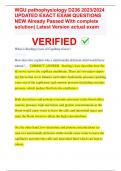
-
WGU pathophysiology D236 2023/2024 UPDATED EXACT EXAM QUESTIONS NEW Already Passed With complete solution| Latest Version actual exam
- Exam (elaborations) • 85 pages • 2023
-
- $16.39
- + learn more
What is Starling's Law of Capillary forces? How does this explain why a nutritionally deficient child would have edema? - CORRECT ANSWER Starling's Law describes how fluids move across the capillary membrane. There are two major opposing forces that act to balance each other, hydrostatic pressure (pushing wa-ter out of the capillaries) and osmotic pressure (including oncontic pressure, which pushes fluid into the capillaries). Both electrolytes and proteins (oncontic pressure) in...
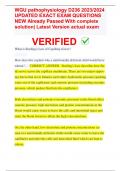
-
WGU pathophysiology D236 2023/2024 UPDATED EXACT EXAM QUESTIONS NEW Already Passed With complete solution| Latest Version actual exam
- Exam (elaborations) • 85 pages • 2023
-
- $16.39
- + learn more
What is Starling's Law of Capillary forces? How does this explain why a nutritionally deficient child would have edema? - CORRECT ANSWER Starling's Law describes how fluids move across the capillary membrane. There are two major opposing forces that act to balance each other, hydrostatic pressure (pushing wa-ter out of the capillaries) and osmotic pressure (including oncontic pressure, which pushes fluid into the capillaries). Both electrolytes and proteins (oncontic pressure) in...

That summary you just bought made someone very happy. Also get paid weekly? Sell your study resources on Stuvia! Discover all about earning on Stuvia

